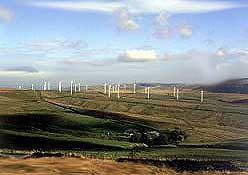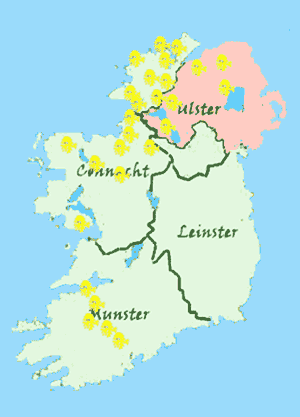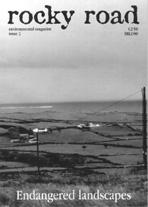|
from 14 july 2002 blue vol II, #41 |
|
|
Part 1: Big business steals green clothing
by Anne Ruimy
An unusual consensus is also developing, particularly in England and Ireland, on what the solutions to the problem should be. The world's largest offshore windfarm is under development off the coast of Arklow in Co. Wicklow, 70km south of Dublin, and Earthwatch (Friends of the Irish Environment) climate campaigner Jim Woolridge gives the news an unqualified welcome. "This is exactly the kind of thing we have been agitating for since Earthwatch was founded... So, to quote Maggie Thatch, Rejoice!" he writes in the summer 2002 issue of Earthwatch.
Objections to windfarms, particularly onshore, are confined to individuals or communities to be affected by a proposed development in their vicinity. These are quickly dismissed as having "not in my backyard" (NIMBY) concerns. Organizations such as the Country Guardians in England have a wider focus: "fighting commercial windfarms on our finest coasts and hills," but such organized groups are equally dismissed, this time for being "fronts" for the nuclear or the fossil fuel industry.
In fact it is difficult to find anybody today, on the right, the left or the green sides of the political spectrum to say a bad word about the wind energy business. It hasn't always been so. The evolution of the politics of climate change is following a scenario that many environmental issues have followed in the past.
In The Tragedy of the Commons Revisited (1969), Beryl Crowe analyses the perverse effect of trying to administer the rights to use a "commons," in this case the right to pollute by emitting climate-changing greenhouse gases into the atmosphere.
"The life cycle is launched by an outcry so widespread and demanding that it generates enough political force to bring about establishment of a regulatory agency to insure the equitable, just, and rational distribution of the advantages among all holders of interest in the commons," writes Crowe.
"This phase is followed by the symbolic reassurance of the offended as the agency goes into operation, developing a period of political quiescence among the great majority of those who hold a general but unorganized interest in the commons. Once this political quiescence has developed, the highly organized and specifically interested groups who wish to make incursions into the commons bring sufficient pressure to bear through other political processes to convert the agency to the protection and furthering of their interests. In the last phase even staffing of the regulating agency is accomplished by drawing the agency administrators from the ranks of the regulated."
The global politics of climate change are closely following this life cycle. Let us take America as an example.
Phase 1: Public outcry. Environmentalists, backed by growing scientific evidence, have warned of the dangers of emitting unsustainable quantities of greenhouse gases in the atmosphere for years.
They were opposed by powerful coalitions of oil interests such as the Global Climate Coalition which orchestrated a campaign of denigration of climate change science surrounding the Kyoto conference in 1997. President Bush was attacked by anti-globalization protesters in 2001 for claiming that there is no scientific basis to the theory that greenhouse gas emissions are changing our climate, and pulling out of the Kyoto protocol shortly after his controversial election. Bush subsequently changed his tune. His most recent stance is admitting to the reality of climate change but proposing an "effective and science-based response" using "creative" solutions "drawing on the powers of markets and technology."
Phase 2: Political quiescence: The Association of State Green Parties in the US now too believe in drawing on the powers of market and technology, when they ask for a "massive conversion to hydrogen fuel cell technology and low-cost wind turbines, photovoltaic modules, and solar thermal energy over the next generation." The are not alone. The Sierra club, a powerful environmental organization felt for example that they had to write in support of the development of the Addison Wind Farm in Wisconsin. The fate of the proposed wind energy project has however divided the community of Addison, a rural town. A resident of Addison felt blackmailed in trading the degradation of a local community and environment for the elusive alleviation of global climate change.
He wrote: "Big business and government have created the NIMBY stick to hit ordinary people over the head with so that they will believe that they are doing something wrong. If you feel shy about standing up for yourself and your family, you are less likely to stand in their way... Dig into the issues that most NIMBYs are fighting and you will find that things are usually not as clean as they appear on the outside. Follow the money involved in any big project and you will find the driving forces are more often about putting dollars into the hands of the already wealthy than about the "greater good" of the community."
Phase 4: Now watch closely as the interest groups get organized, not only to share the spoils of changes in legislation but to influence policy making. What is at stake is the share of public funding allocated to renewable energy and other technofixes to climate change. In a 'free' trade world, was is also at stake is the competition between parties interested in wind, solar, biomass, even nuclear energy, carbon sinks, as well as those who advocate increasing the energy efficiency of traditional fossil fuel plants. It is the widespread recognition of this fact that has led the wind energy industry and its lobbyists, 'renewable' energy advocacy groups, electric generating companies, the U.S. Department of Energy, and DOE laboratories to lobby for a wide variety of tax breaks and other subsidies. Those interest groups have been amazingly effective. Their efforts have resulted in a host of federal and state tax shelters and other subsidies made available to wind farm developers. When the effects of these tax shelters and subsidies are taken into account, wind farms are a highly profitable venture. Seldom mentioned, however, is the cost-shifting effect of the tax shelters and other subsidies. The true costs of wind farm projects are shifted away from the owners and developers, and to electric customers and taxpayers.
Who would have thought only a few years ago that reforestation, particularly in the West of Ireland and the Scottish Highlands, would ever become a dirty word? Wasn't reforestation what environmentalists had been "agitating" for years? Yet now reforestation means hectares of monocultures, destruction of landscapes, decline of water quality, loss of biodiversity, threats to wildlife and sensitive ecosystems, rural depopulation among many disastrous environmental and social impacts - all paid for by tax payers and fiercely protected by interest groups. It took years for environmentalists, and more so the 'general public,' to understand that tree 'farming' is not necessarily good. It might take a few more years to understand that the big names in wind 'farm' development are not 'green' companies, and their other activities often add to atmospheric pollution far greater amounts of noxious gases than their windfarms save.
Yet environmentalists are silenced. Rather than quickly dismissing local objectors by borrowing verbatim the PR arguments of the wind industry, the first thing environmentalists should do is start listening to those fighting wind developments in their backyards. An intelligent, informed and respectful discussion should follow.
Questions should be debated, such as:
|
|||
|
BLUE is looking for short fiction, extracts of novels, poetry, lyrics,
polemics, opinions, eyewitness accounts, news, features, information and arts
in any form relating to eco cultural- social- spiritual issues, events and
activites (creative and political). Send to Newsdesk. |


 Have you noticed that climate change has suddenly become the environmental issue of the day? Not only does the issue inspire a flurry of magazine and newspaper articles, public conferences, protests and campaigns, but now even newly converted business people and mainstream politicians are lecturing us on collapsing ice shelves, emperor penguins and the plight of South African coal diggers.
Have you noticed that climate change has suddenly become the environmental issue of the day? Not only does the issue inspire a flurry of magazine and newspaper articles, public conferences, protests and campaigns, but now even newly converted business people and mainstream politicians are lecturing us on collapsing ice shelves, emperor penguins and the plight of South African coal diggers.
 Phase 3: Enter the interest groups. Despite the fact that the US has still not signed up to the Kyoto agreement, Kyoto implementation is becoming more of a framework for trading carbon emissions globally than an effective and fair tool to reduce them. Now Big Oil and other business and state agencies in need of greenwashing are jumping on the opportunity to take advantage of the political and financial incentives to invest in commercial projects of renewable energy. Private wind developers can make profits fueled, depending on the country, by a combination of fixed prices per kWh (often upgraded for wind energy), tax credits, some tax exemptions, renewable energy credits, and subsidies which make the proposals increasingly attractive to financiers in deregulated energy markets. The bulk of public money allocated to follow Kyoto targets goes to subsidizing "technofixes" such as industrial wind farms, loopholes such as "carbon sinks" in commercial monoculture forestry, and research into even more worrying sci-fi projects such as artificial iron fertilization of oceans.
Phase 3: Enter the interest groups. Despite the fact that the US has still not signed up to the Kyoto agreement, Kyoto implementation is becoming more of a framework for trading carbon emissions globally than an effective and fair tool to reduce them. Now Big Oil and other business and state agencies in need of greenwashing are jumping on the opportunity to take advantage of the political and financial incentives to invest in commercial projects of renewable energy. Private wind developers can make profits fueled, depending on the country, by a combination of fixed prices per kWh (often upgraded for wind energy), tax credits, some tax exemptions, renewable energy credits, and subsidies which make the proposals increasingly attractive to financiers in deregulated energy markets. The bulk of public money allocated to follow Kyoto targets goes to subsidizing "technofixes" such as industrial wind farms, loopholes such as "carbon sinks" in commercial monoculture forestry, and research into even more worrying sci-fi projects such as artificial iron fertilization of oceans.
 But back to Ireland and England.
But back to Ireland and England.
